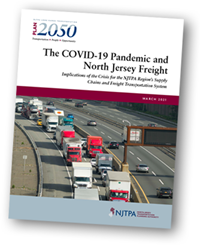 The COVID-19 pandemic disrupted North Jersey’s freight system, but the public and private sectors drew on lessons from previous disruptions to rapidly restore effective operations. Now they must turn to adapting the system to address lasting impacts of the crisis. Those are among the conclusions of COVID-19 and North Jersey Freight, an report issued as part of the NJTPA’s research for sits upcoming long-range transportation plan, Plan 2050: Transportation, People, Opportunity.
The COVID-19 pandemic disrupted North Jersey’s freight system, but the public and private sectors drew on lessons from previous disruptions to rapidly restore effective operations. Now they must turn to adapting the system to address lasting impacts of the crisis. Those are among the conclusions of COVID-19 and North Jersey Freight, an report issued as part of the NJTPA’s research for sits upcoming long-range transportation plan, Plan 2050: Transportation, People, Opportunity.
According to the paper, available on the Plan 2050 website, experience with September 11, 2001 and Superstorm Sandy “helped the region’s freight sector respond and adjust” to the pandemic. In particular, the region recognized the importance of “collaboration, coordination, and communication” to prevent the shutdown of distribution of food and other essential goods.
One example of collaboration was the formation of the New Jersey Food and Supply Chain Team with members of government, industry and the non-profit sector. Among other efforts, the team helped address food shortages in the state by assisting with repurposing goods that were not being used by closed restaurants. The Council on Port Performance, formed during Superstorm Sandy, helped ensure continued port operations. After a sharp decline in containers handled at the port in spring 2020, volumes bounced back to record levels by the fall, according the paper.
The crisis accelerated several trends that had already been underway, leading to lasting changes in regional freight. One was the growth of e-commerce. According to the paper, in 2010, e-commerce sales represented 6.4 percent of all U.S. retail sales. That grew to 21.3 percent in 2020, a 44 percent increase over the previous year. Companies have had to adjust their supply and distribution operations, including investing in new warehouse facilities. They have also faced labor shortages.
Among other changes cited in the paper were shifting production from unreliable overseas suppliers, maintaining more inventory on-hand, and enhanced deployment of technology and automation options.
As part of efforts to meet these trends, the paper calls for continued efforts to optimize the region’s multimodal freight system and “to apply effective practices, learn new lessons and pivot to the changing needs of people and businesses.”